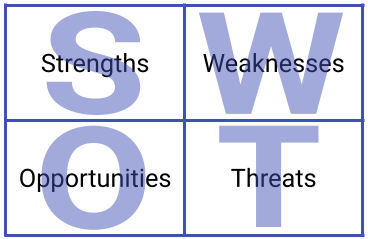 SWOT analysis is one of the most familiar tools in a manager’s toolkit, yet it’s often misunderstood and misused. While it’s simple to grasp, too many leaders see it as little more than a box-ticking exercise, resulting in a laundry list of items that don't lead to actionable strategy. But when used correctly, SWOT analysis can be a powerful way to summarise your business situation and generate strategic options. Let’s dive into how to make SWOT work for you and why it deserves a place in your strategic planning.
SWOT analysis is one of the most familiar tools in a manager’s toolkit, yet it’s often misunderstood and misused. While it’s simple to grasp, too many leaders see it as little more than a box-ticking exercise, resulting in a laundry list of items that don't lead to actionable strategy. But when used correctly, SWOT analysis can be a powerful way to summarise your business situation and generate strategic options. Let’s dive into how to make SWOT work for you and why it deserves a place in your strategic planning.
The Real Value of SWOT Analysis
SWOT stands for Strengths, Weaknesses, Opportunities, and Threats. It’s a structured way to think about your business environment, combining internal (Strengths and Weaknesses) and external (Opportunities and Threats) perspectives. However, many leaders miss the real power of SWOT by treating it as a static exercise rather than an evolving process.
A common critique, like that of strategy expert Roger Martin, suggests that SWOT doesn’t produce “blinding insights” and should be tossed aside. However, this criticism often stems from a misunderstanding of how to use SWOT effectively. The right question isn’t “What insights come out of a SWOT analysis?” but rather, “What valuable insights do you put into it and how do you connect them together?”
SWOT is not about throwing random facts onto a page. It’s about connecting insights in a meaningful way that drives strategic decision-making. When used as a dynamic, iterative process, SWOT can guide you towards clarity and action, making it much more than a simple summary tool.
Common Pitfalls in SWOT Analysis
One of the main issues with SWOT is that it often produces a disconnected list of strengths, weaknesses, opportunities, and threats that don’t align with the business’s strategic goals. This problem usually arises when people approach the analysis mechanically, filling each section in order without considering the bigger picture. Here are the two most common approaches:
-
Inside-Out Approach: This is the traditional method, where you start by identifying your strengths and weaknesses before looking at external opportunities and threats. While familiar, it can lead to a narrow focus that misses key external drivers.
-
Outside-In Approach: This starts with the external environment—opportunities and threats—before identifying which internal strengths to leverage and weaknesses to address. This approach can be particularly useful when you already have a clear idea of where you want to go but need to refine how you’ll get there.
Both approaches can be effective, but they require a critical eye and a willingness to dig deeper beyond the obvious.
How to Get the Most Out of Your SWOT Analysis
To make your SWOT analysis a powerful strategic tool, consider these three key tips:
-
Start with a Clear Business Goal: Before you even begin filling in your SWOT, ensure that you have a well-defined business goal in mind. This will keep your analysis focused and relevant, preventing you from listing irrelevant items that don’t serve your strategic aims. Sense-check every item you include in the context of your business goal.
- Incorporate a Diversity of Perspectives: It usually takes a team to complete a SWOT, and you should choose yours carefully. That is, people from inside and outside the organisation, and from across different roles within the organisation. People and their perspectives can be included directly, for example, through a collaborative workshop, intermediated through interviews or surveys, or through secondary research.
-
Connect the Dots: SWOT analysis should be more than just four lists of unrelated points. Make connections between the elements. For example, if you identify a strength like a robust sales capability, ask how it relates to an opportunity like product line expansion. By linking elements across the SWOT, you’ll start to see how they can work together to drive strategy. The TOWS framework is a very useful extension of SWOT for this purpose.
-
Iterate and Refine: Your first draft of a SWOT analysis is unlikely to be perfect. Take the time to iterate, refine, and filter. Remove any points that don’t connect with others or align with your strategic goals. This iterative process helps turn an initial scattershot of ideas into a coherent strategy map.
Why Leaders Should Revisit SWOT Regularly
According to Eric Partaker, only 30% of leaders review their strategy regularly. Regularly revisiting your SWOT analysis can help ensure that your strategy stays relevant and responsive to changing circumstances. SWOT analysis is your “success map”—a living document that shows you where to focus, where you stand, and where to go next.
By continually focusing on your strengths, addressing weaknesses, seizing opportunities, and guarding against threats, you maintain a clear picture of your business landscape. This allows you to make strategic adjustments and stay ahead of the competition.
NB: StratNavApp will automatically remind you to update your SWOT analysis. So you never need worry about it getting out of date.
Bringing SWOT to Life: Beyond Static Lists
SWOT analysis shouldn’t be passive. A modern strategy tool, like StratNavApp.com, elevates SWOT from a simple summary to an active driver of strategy. The platform allows you to rate and filter insights by impact and certainty, link them to other strategy elements, and actively explore how different factors interact. This approach transforms SWOT from a paper exercise into a dynamic tool that continuously informs your strategic direction.
Attempts to replace SWOT
I've seen many attempts to replace SWOT analysis over the years. I'd struggle to name one - because they tend to fade into obscurity as rapidly as they arrive.
The reason I believe is that they miss two important attributes of SWOT:
- SWOT is MECE
MECE stands for Mutually Exclusive and Completely Exhaustive. It's an important concept in analysis. It basically means that everything has one place and one place only in the framework.
SWOT achieves this because every insight on a SWOT is either ceterus paribus Positive or Negative for the organisation and Within or Not Within its control.
If your SWOT entries don't obviously fall into those categories, it is because they are not properly processed insights, and you should read Are your strategic insights insightful? - SWOT maintains the separation of responsibilities
SWOT concerns itself with the categorisation of insights only. And it concerns itself with the categorisation of all strategic insights. It is very singular in its purpose, and very good at it.
Alternatives typically make one of two mistakes.
Firstly, they don't provide a place for some types of insights. Leaving you with the problem of what to do with them to ensure they don't get left out of the process.
Secondly, they try and do things with the insights, such as incorporating decisions or plans based on those insights, when those things are best achieve through other purpose made (and therefore more capable) frameworks.
Conclusion: In Defence of SWOT Analysis
SWOT analysis remains a valuable tool when used correctly. It’s not about filling boxes for the sake of it; it’s about creating a canvas for exploring insights and making meaningful connections that inform strategic action. So, before dismissing SWOT as outdated or irrelevant, reconsider how you’re using it. Start with clear goals, connect the dots, iterate, and keep your analysis dynamic. With the right approach, SWOT can be a strategic powerhouse that helps guide your business to success.
Most criticisms of SWOT fall apart when you compare them to similar criticisms of a simple hammer:
- Not everything is a nail. A carpenter needs a full toolkit, and to know how and when to use each tool. But all of those tools have value.
- Some people are bad with hammers. The hit their thumbs, they hammer the nails in skew, they damage the surfaces they're hammering into. So, of course, you want to try and avoid those problems, or hire a professional.
- Sometimes a nail gun is better. But it you think unskilled workers can do damage with a hammer, imagine what damage they can cause with a nail gun. And sometimes simpler really just is better.
The answer is not to get rid of hammers, but to use them well for the jobs they're good at.
Next Steps
You can do your next SWOT on StratNav:
- It's collaborative, so everyone can participate, reducing the risk of blind spots.
- Our AI can guide you with suggestions and questions which are tailored to your business needs.
- It integrates with our comprehensive and integrated strategy system, so you're not just doing a SWOT, you're developing and executing and end-to-end business strategy.
You can get started right away:
- Sign up for free at https://www.stratnavapp.com
- Schedule a free demo at https://www.stratnavapp.com
See also:
- How to do a SWOT analysis? (With example and template)
- 13 tips and techniques to help you do a better SWOT analysis
- Examples of SWOT analyses
- About Strategic Insights
- Working with Insights and Insight-based models
